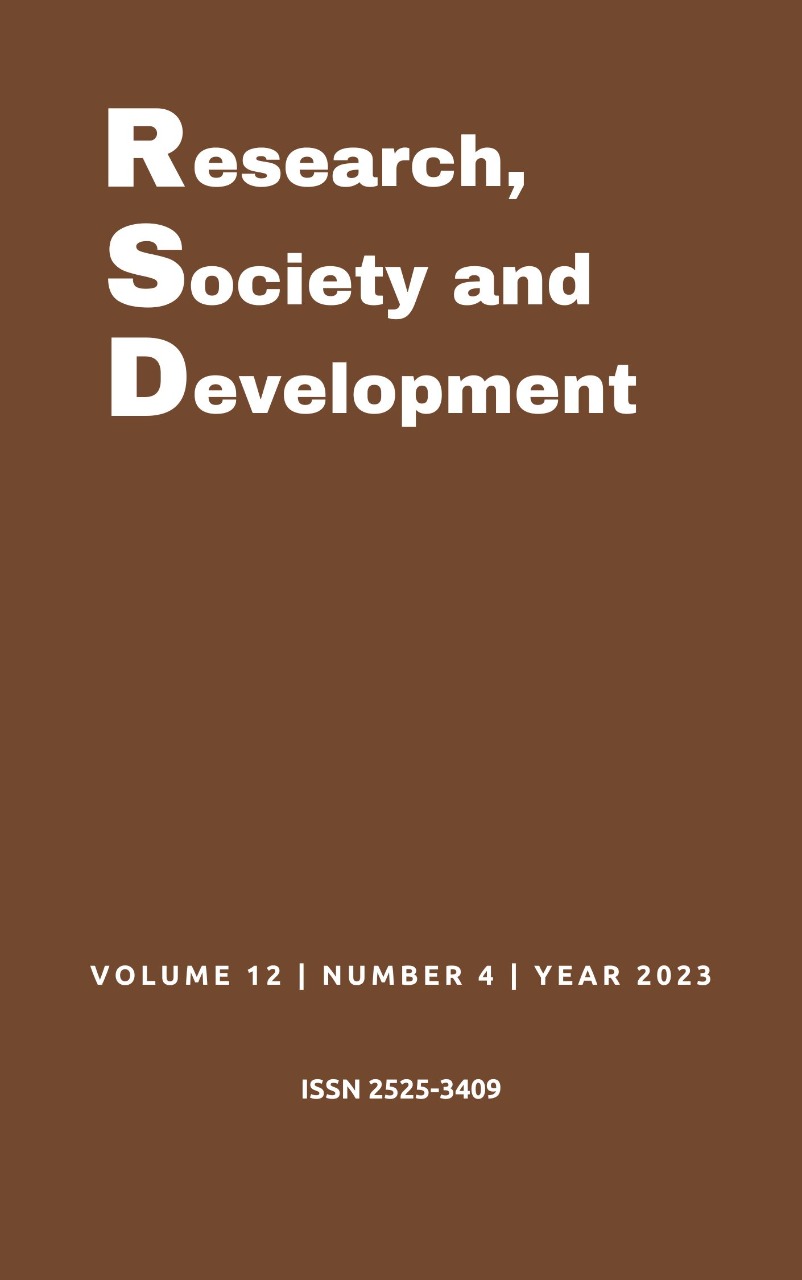Disfunción endotelial y complicaciones trombóticas asociadas al SARS-CoV-2 en adultos: una revisión sistemática
DOI:
https://doi.org/10.33448/rsd-v12i4.40859Palabras clave:
SARS-CoV-2, Adulto, Disfunción endotelial, Complicaciones trombóticas.Resumen
Introducción: Durante la pandemia se observaron ocurrencias de complicaciones tromboembólicas y disfunciones endoteliales asociadas a la COVID-19. Sin embargo, la fisiopatología de los mecanismos de acción no está completamente dilucidada. Métodos: Con el objetivo de una mejor comprensión de los mecanismos asociados de la función endotelial debido a COVID-19, se realizó una revisión sistemática utilizando bases de datos índice y un proceso de selección en el que los criterios de inclusión fueron artículos que abordan el mecanismo de eventos trombóticos por disfunción endotelial. y publicaciones que asocian COVID-19 con complicaciones trombóticas en adultos de hasta 59 años. Conclusión: el SARS-CoV-2 está asociado con una función endotelial alterada por mecanismos endoteliales inducidos por infección y lesión viral directa, lo que lleva a cambios en el eje angiotensina II/AT1 y respuesta inflamatoria.
Referencias
Agrati et al. (2021). Elevated P-selectin in severe Covid-19: Considerations for therapeutic options. Mediterranean Journal of Hematology and Infectious Diseases. http://dx.doi.org/10.4084/MJHID.2021.016
Almyroudi M., & Dimopoulos G. (2020). Incidence, pathogenesis and management of thromboembolic complications in severe COVID-19. Pneumon. https://www.embase.com/search/results?subaction=viewrecord&id=L2006128138&from=export
Amoah, Gunasekaran, Rahi e Buscher. (2020). A case of secondary tension pneumothorax in COVID-19 pneumonia in a patient with no prior history of lung disease. SAGE Journals Open Medical Case Reports. http://dx.doi.org/10.1177/2050313X20967504
Canzano et al. (2020). Disantangling the mechanisms behind the thrombotic complications of COVID-19 Patients: insights into platelet and endotelial activation. Research and Practice in Thrombosis and Haemostasis. http://dx.doi.org/10.1002/rth2.12413
Carmeliet P. (2021). Single vascular cell heterogeneity in health and disease: A COVID-19 update. Topics in Antiviral Medicine. https://www.embase.com/search/results?subaction=viewrecord&id=L635068396&from=export
Chen W., & Pan J. (2021). Anatomical and Pathological Observation and Analysis of SARS and COVID-19: Microthrombosis is the Main Cause of Death. BMC Biological Procedures Online. http://dx.doi.org/10.1186/s12575-021-00142-y
Della Rocca et al. (2021). Evidence of systemic endotelial injury and microthrombosis in hospitalized COVID-19 patients at different stages of the disease. Journal of Thrombosis and Thrombolysis. https://doi.org/10.1007/s11239-020-02330-1
Fei, Tang, Liu e Cao (2020). Coagulation Dysfunction: A Hallmark in COVID-19. Archives of Pathology & Laboratory Medicine. https://doi.org/10.5858/arpa.2020-0324-SA
Freda et al. (2021). SARS-CoV-2 Structural Proteins Exposure Alter Thrombotic and Inflammatory Responses in Human Endothelial Cells. Cellular and Molecular Bioengineering. http://dx.doi.org/10.1007/s12195-021-00696-7
Gencer et al. (2020). Immunoinflammatory, Thrombohaemostatic and Cardiovascular Mechanisms in COVID-19. Thrombosis and Haemostasis. http://dx.doi.org/10.1055/s-0040-1718735
Giannis et al. (2020). Thromboembolic outcomes of hospitalized COVID-19 patients in the 90-day- post-discharge period: early data from the northwell core-19 registry. Blood. https://doi.org/10.1182/blood-2020-141901
Ma, Yang, Huang e Lui (2020). Endothelial contribution to COVID-19 : an update on mechanisms and therapeutic implications. Journal of Molecular and Cellular Cardiology. 164. https://www.jmcc-online.com/article/S0022-2828(21)00225-X/fulltext#secst0055
Nagashima et al. (2020). Endothelial dysfunction and thrombosis in patients with COVID-19 – Brief report. Arteriosclerosis, Thrombosis and Vascular Biology. http://dx.doi.org/10.1161/ATVBAHA.120.314860
Pamplona M. (2022). Figure 1. PRISMA study selection and inclusion process flowchart.
Pamplona M. (2022). Figure 2. Activation of the inflammatory and thrombotic mechanism by SARS-CoV-2.
Pamplona M. (2022). Figure 3. Parameters in critically ill patients with Covid-19.
Pamplona M. (2022). Table 1: Search Strategy.
Pamplona M. (2022). Table 2: Bibliographic search results table.
Pamplona M. (2022). Table 3. Thrombotic Complications.
Róman et al. (2020). The neurology of COVID-19 revisited: A proposal from the Environmental Neurology Specialty Group of the World Federation of Neurology to implemente international neurological registries. Journal of the neurological sciences. 414. https://doi.org/10.1016/j.jns.2020.116884
Shmaier et al. (2021). Tie2 activation protects Against prothrombotic endotelial dysfunction in COVID-19. JCI Insight. http://dx.doi.org/10.1172/jci.insight.151527
WHO - World Health Organization (2020).
Zhang et al. (2020). SARS-CoV-2 binds platelet ACE2 to enhance thrombosis in COVID-19. Journal of Hematology & Oncology. https://jhoonline.biomedcentral.com/articles/10.1186/s13045-020-00954-7
Descargas
Publicado
Número
Sección
Licencia
Derechos de autor 2023 Mariane Arakawa Pamplona; José Hittalo Taveira; Karina Magalhães da Mata; Kleber Silva Moraes; Ana Beatriz de Assis Ribeiro; Maria Clara Mendonça França; Cleverson Rodrigues Fernandes

Esta obra está bajo una licencia internacional Creative Commons Atribución 4.0.
Los autores que publican en esta revista concuerdan con los siguientes términos:
1) Los autores mantienen los derechos de autor y conceden a la revista el derecho de primera publicación, con el trabajo simultáneamente licenciado bajo la Licencia Creative Commons Attribution que permite el compartir el trabajo con reconocimiento de la autoría y publicación inicial en esta revista.
2) Los autores tienen autorización para asumir contratos adicionales por separado, para distribución no exclusiva de la versión del trabajo publicada en esta revista (por ejemplo, publicar en repositorio institucional o como capítulo de libro), con reconocimiento de autoría y publicación inicial en esta revista.
3) Los autores tienen permiso y son estimulados a publicar y distribuir su trabajo en línea (por ejemplo, en repositorios institucionales o en su página personal) a cualquier punto antes o durante el proceso editorial, ya que esto puede generar cambios productivos, así como aumentar el impacto y la cita del trabajo publicado.


